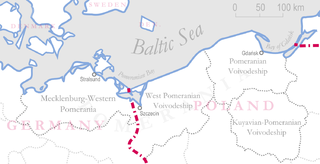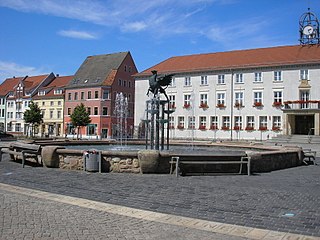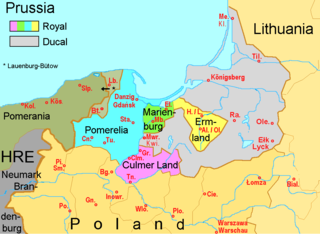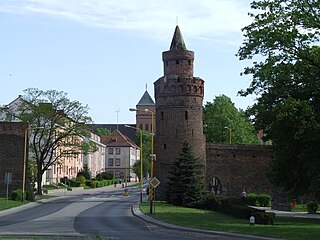
Pomerania is a historical region on the southern shore of the Baltic Sea in Central Europe, split between Poland and Germany. The western part of Pomerania belongs to the German states of Mecklenburg-Western Pomerania and Brandenburg, while the eastern part belongs to the West Pomeranian and Pomeranian voivodeships of Poland. Its historical border in the west is the Mecklenburg-Western Pomeranian border valley, which now constitutes the border between the Mecklenburgian and Pomeranian part of Mecklenburg-Western Pomerania, while it is bounded by the Vistula River in the east. The easternmost sub-regions of Pomerania are alternatively known as Pomerelia and Kashubia, which are inhabited by ethnic Kashubians.

Szczecin is the capital and largest city of the West Pomeranian Voivodeship in northwestern Poland. Located near the Baltic Sea and the German border, it is a major seaport and Poland's seventh-largest city. As of December 2019, the population was 401,907.

Anklam [German pronunciation: [ˈaŋklam](listen)], formerly known as Tanglim and Wendenburg, is a town in the Western Pomerania region of Mecklenburg-Vorpommern, Germany. It is situated on the banks of the Peene river, just 8 km from its mouth in the Kleines Haff, the western part of the Stettin Lagoon. Anklam has a population of 14,603 (2005) and was the capital of the former Ostvorpommern district. Since September 2011, it has been part of the district of Vorpommern-Greifswald.

Swedish Pomerania was a Dominion under the Swedish Crown from 1630 to 1815, situated on what is now the Baltic coast of Germany and Poland. Following the Polish War and the Thirty Years' War, Sweden held extensive control over the lands on the southern Baltic coast, including Pomerania and parts of Livonia and Prussia.

Pomerelia, also referred to as Eastern Pomerania or Gdańsk Pomerania, is a historical sub-region of Pomerania, in northern Poland. Pomerelia lay on the southern shore of the Baltic Sea, west of the Vistula river and east of the Łeba river. Its largest and most important city is Gdańsk. Since 1999 the region has formed the core of the Pomeranian Voivodeship. Gdańsk Pomerania is traditionally divided into Kashubia and Kociewie, which are inhabited by ethnic Kashubians and speakers of the Kashubian language.

Pyrzyce, is a town in Pomerania, north-western Poland, with 13,331 inhabitants (2007).

The history of Pomerania starts shortly before 1000 AD with ongoing conquests by newly arrived Polans rulers. Before that the area was recorded nearly 2000 years ago as Germania, and in modern-day times Pomerania is split between Germany and Poland. The name Pomerania comes from the Slavic po more, which means Land at the Sea.

The Pomeranian Evangelical Church was a Protestant regional church in the German state of Mecklenburg-Vorpommern, serving the citizens living in Hither Pomerania. The Pomeranian Evangelical Church was based on the teachings brought forward by Martin Luther and other Reformators during the Reformation. It combined Lutheran and Reformed traditions. The seat of the church was Greifswald, the bishop's preaching venue was the former Collegiate Church of St. Nicholas in Greifswald.

Farther Pomerania, Further Pomerania, or Eastern Pomerania, is the part of Pomerania which comprised the eastern part of the Duchy and later Province of Pomerania. It stretched roughly from the Oder River in the West to Pomerelia in the East. Since 1945, Farther Pomerania has been part of Poland; the bulk of former Farther Pomerania is within the West Pomeranian Voivodeship, while its easternmost parts are within the Pomeranian Voivodeship. The Polish term Pomorze Zachodnie, in modern Polish usage, is a synonym to the West Pomeranian Voivodship; in Polish historical usage it applied to all areas west of Pomerelia.

The Province of Pomerania was a province of Prussia from 1815 to 1945. Pomerania was established as a province of the Kingdom of Prussia in 1815, an expansion of the older Brandenburg-Prussia province of Pomerania, and then became part of the German Empire in 1871. From 1918, Pomerania was a province of the Free State of Prussia until it was dissolved in 1945 following World War II, and its territory divided between Poland and Allied-occupied Germany.

The Archdiocese of Berlin is a Roman Catholic archdiocese, seated in Berlin and covering the northeast of Germany.

Pomerania during the Early Modern Age covers the history of Pomerania in the 16th, 17th, and 18th centuries.

The Province of Pomerania was a province of Brandenburg-Prussia, the later Kingdom of Prussia. After the Thirty Years' War, the province consisted of Farther Pomerania. Subsequently, the Lauenburg and Bütow Land, Draheim, and Swedish Pomerania south of the Peene river were joined into the province. The province was succeeded by the Province of Pomerania set up in 1815.

History of Pomerania (1806–1933) covers the history of Pomerania from the early 19th century until the rise of Nazi Germany.
The Duchy of Pomerania was partitioned several times to satisfy the claims of the male members of the ruling House of Pomerania dynasty. The partitions were named after the ducal residences: Pomerania-Barth, -Demmin, -Rügenwalde, -Stettin, -Stolp, and -Wolgast. None of the partitions had a hereditary character, the members of the House of Pomerania inherited the duchy in common. The duchy thus continued to exist as a whole despite its division. The only exception was made during a war with the Margraviate of Brandenburg, when in 1338 Barnim III of Pomerania-Stettin was granted his partition as a fief directly from the Holy Roman Emperor, while Pomerania-Wolgast remained under formal Brandenburgian overlordship. However, already in 1348, German king and later emperor Charles IV again granted the Duchy of Pomerania as a whole and the Principality of Rügen as a fief to the dukes of both Pomerania-Stettin and Pomerania-Wolgast, nullifying Brandenburg's claims by granting Imperial immediacy.

The Region of Stralsund belonged to the Prussian Province of Pomerania and existed from 1818 to 1932.

Wilhelm Malte I, Prince of Putbus was a German prince (Fürst) from the old Slavic-Rügen noble family of the lords of Putbus. He acted as a Swedish governor in Swedish Pomerania and later, under Prussian rule, as the chairman of the regional council (Kommunallandtag) of Pomerania and Rügen.

Western Pomerania, also called Hither Pomerania, is the western extremity of the historic region of the Duchy, later Province of Pomerania, nowadays divided between the German state of Mecklenburg-Vorpommern and Poland.
New Western Pomerania was that part of Western Pomerania that went to Prussia under the terms of the Congress of Vienna in 1815.















